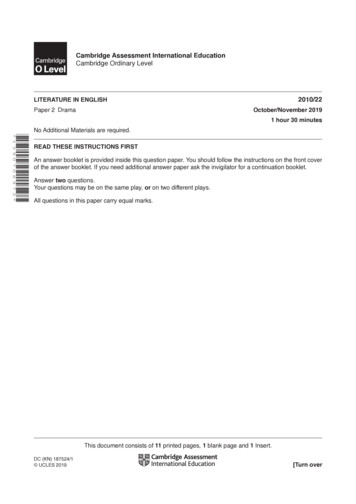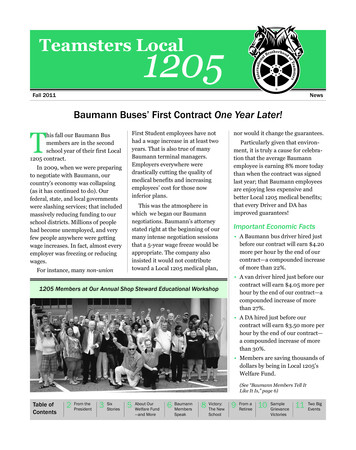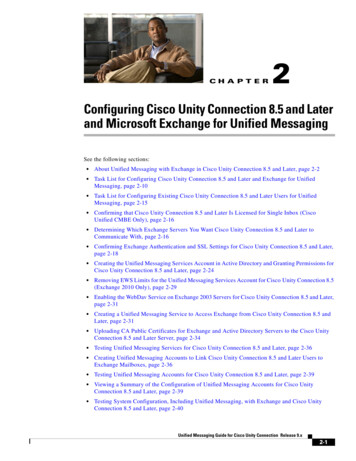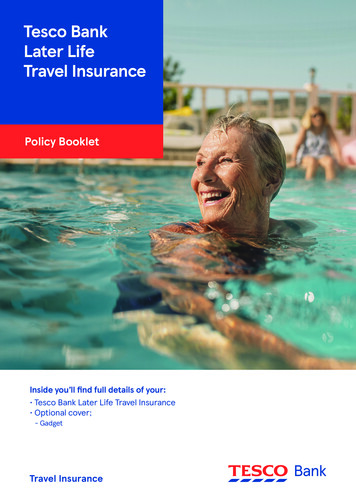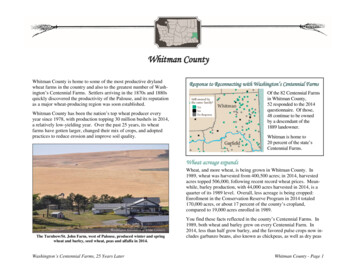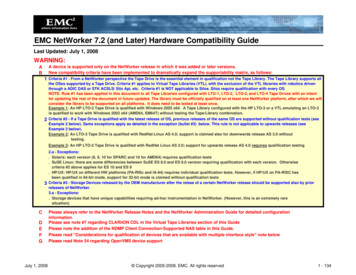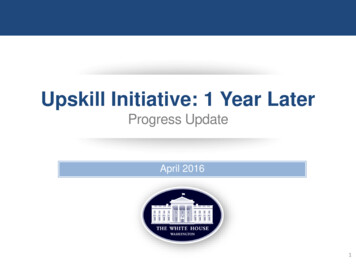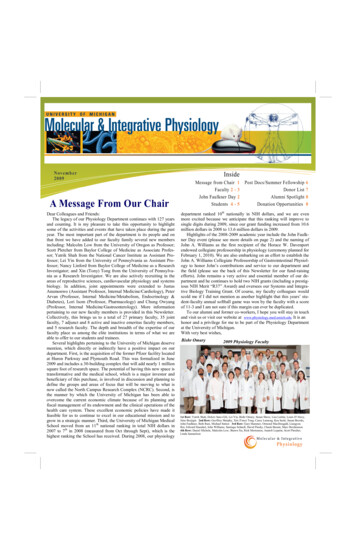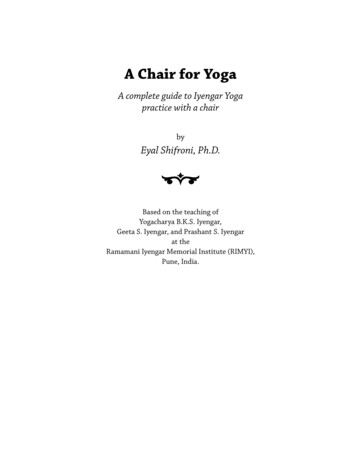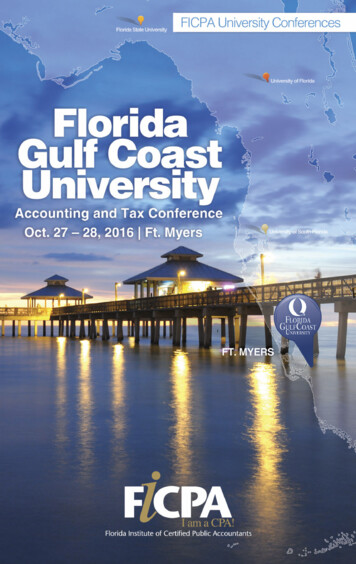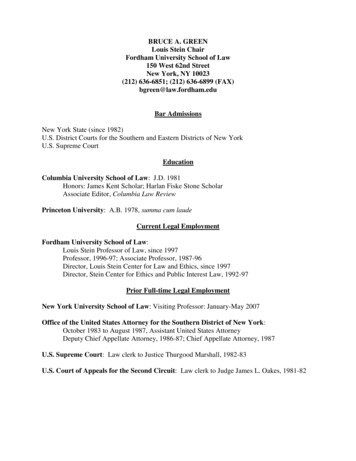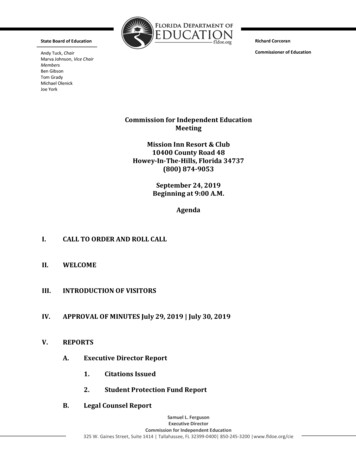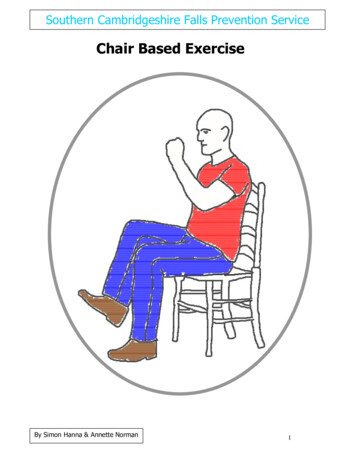
Transcription
Southern Cambridgeshire Falls Prevention ServiceChair Based ExerciseBy Simon Hanna & Annette Norman1
This book is dedicated to the memory ofEdith Olive Anthony ChecklandIntroductionThis booklet contains exercises aimed at older peoplewho wish to either maintain or increase theirindependence.Research has shown that many of the exercises canhelp to strengthen muscles and bone. Strongermuscles make every day activities such as washing,dressing, shopping or doing house work easier and lessof a strain. You are less likely to injure your self doingeveryday activities, stronger muscles help to improvebalance and walking. There are exercises included thatwill help to improve your circulation which in turn willhelp to lessen cramp and help to keep you warmer.2
BENEFITS OF EXERCISEPROBLEM IEXERCISE CAN HELP BECAUSEWHAT YOU WILL NOTICE Improves stamina and musclepower Removes waste quicker Stimulates circulation to allorgans including the brain Lose weight It is easier to move from placeto placeHelps lower cholesterol level, stresshormones and muscle tension Helps lower blood pressure Keeps the heart muscle strong Aids circulation and helps bloodand body fluids to move Feel better, more energeticOVERWEIGHT Burns more calories andreplaces inactive fat with muscle. Increases muscle mass Muscles burn calories evenwhen you sleep, so losing weightand keeping it down is easierSWOLLEN FEET The movement of musclesmassages veins so blood and fluidsreturn from the feet. Reduces swollen ankles andfeet. Walking becomes easierHAVE OR WANTTO AVOIDNO ENERGYLAZYSHORT OFBREATHHIGH BLOODPRESSUREHEART ATTACKHEART DISEASESTROKE Feel less sluggish More energy for day-to-dayactivities Feel less dizzy Prevents ankle swelling, bloodclots, leg ulcers and foot pain3
OSTEOPOROSIS Muscle pulling on bonestimulates bone growth, makingbones stronger and less likely tobreakSTANDING OR WEIGHT BEARING FOR4 HOURS A DAY HELPSARTHRITISCANCER:Breast, colon,prostateKIDNEYDISEASE Less likely to break a bone ifyou fall Less pain Better posture helps preventfalls Stronger muscles help to holdthe joints in correct position sothere is less wear and tear onthem Moving joints helps to “nourish”them and keeps a good range ofmovement. Less wear and tear on jointsmeans less PAIN You will be able to keep doingthings for yourself: (wash hair, do Burns fat, which storescarcinogens Gets rid of waste quicker More regular bowel movement Feel more comfortable in theabdomen Burning fat helps to lose weight Lowers blood pressure andblood sugars so less risk to kidneys Being upright helps kidneys todrain Stimulates circulation and thirst Removes body waste and drug“left overs” Kidney infections can causebackache and a general feeling oflethargy. Will feel thirsty, Increased thirstincreases fluid intake, increasedurine flow, flushing kidneys anddecreasing the chance ofstagnation, infections and stonesup buttons, put own shoes on, walk moreeasily and safely) Feel more lively and energeticCAN’T SLEEP ATNIGHTNIGHT VISITSTO THE LOO Using the body during the daywill help muscles relax and rest atnight Helps fluid circulate from legs tokidneys during the day rather thanat night Getting a better night’s sleepwill aid restful sleep, helping youto feel more alert and energetic onwaking4
CONSTIPATIONBLOATING Stimulates circulation and colonactivity Decreases need for medicines Feel more energetic Feel more comfortable Less wind to deal withD EPRESSED Exercise releases endorphins,“feel good” chemicals in the brainwhich help you to feel cheerful andpositive Lose weight Tone up muscles Release of endorphins helps youto feel happy and alert May not need medicine or somany Toning the body and losingweight will make you look better,clothes fit better. Have more self esteem.LOW BACK PAIN Improves abdominal muscletone Improves posture Prevents constipation andbloating which stresses musclescausing pain Better posture and goodabdominal muscles will helpprevent back pain and make youfeel better about yourself Good posture helps inpreventing trips and fallsU RINARY Stimulates muscle tone andthirst, which stimulates urine flow Stronger deep abdominalmuscles will also mean strongerpelvic floor muscles Fear of drinking goes. Drinkingmore will stop dehydration whichcauses headaches and lethargy Moving easier so no delay intoileting, will prevent infection andoverfilling The deep abdominal muscleswork together with the pelvic floormuscle which will make it easier tocontrol the urge to urinate Less fear of accidentshappening Less headaches, feel moreenergetic Exercise increases strength,flexibility and balance. Encourages better posture andbody alignment Decreases wear and tear Decreases chance of falls andinjury More confident to move about Less pain if muscles arestronger Everyday tasks become easierand therefore less tiring, so moreenergy and “verve”.D ON’T LIKE THEWAY I LOOKINCONTINENCEI NJURY5
CHANGE BEHAVIOUR FIRST,ATTITUDE WILL FOLLOWTHE MORE ONE SITS THE WEAKER AND MOREFRAIL ONE BECOMESUSE IT OR LOSE IT!6
It is important that before you start an exercise programme you speakto your Doctor especially if you could answer YES to any of theflowing: Have you at any time been told you have heart trouble or youare being treated for a heart condition? Have you had a heart attack in the last 3 years? Have you had any chest pains while at rest or during exertion? Do you have dizzy spells? Do you have fast, slow or irregular heart beats? Do you have uncontrolled high blood pressure? Have you had diabetes for more than 10 years? Have you had any shortness of breath after mild exertion, at restor even at night in bed? Have you recently broken any bones? Do you have any joint problems? Do you ever get pain in your buttocks, back of your legs, thighsor calves when walking? Do you have swollen ankles, feet or hands? Do you take Diuretics? Have you had more than one fall in the last year? Have you been inactive for more than 3 years and are over 65?If you answer YES or DON’T KNOW to any of the followingquestions you can make an appointment to see your doctor and maywant to discuss a cause of action.7
Fall Problem IdentificationHave you had a fall in the last year?Y NY NY NYES / NOIf yes: Did you hurt yourself or need to call a doctor?YES / NOWere you able to summon help?YES / NOAre you able to do the things you used to, prior to the fall?YES / NOHave you broken any bones as the result of a fall?i.e. from standing height or below (not from a ladder)YES / NO / DON’T KNOWIs there a family history of osteoporosis?(e.g. maternal hip fracture)YES / NO / DON’T KNOWHave you ever been prescribed systemic steroidsfor longer than 3 months?YES / NO / DON’T KNOWBlood PressureWhen did you last have your blood pressure checked?Have you had a check for POSTURAL HYPOTENSION?(when lying to standing blood pressure is checked)Are you on 4 or more medications? YES / NOWhen did you last have a review of your medications by your GP?8
SECTION 1Warming Up/GetMovingIt is important that before you start doing any of theexercises that you are 'warm'. This involvesmovements that will help to promote your circulationand warm your muscles and joints.9
Sitting Posture/Posture check Sit towards the front of the chair so that there is a gap between yourback and the back of the chair. Make sure that your feet are flat on the floor and they are nottucked back under the chair. Your ankles should be directly belowyour knees. Feet and Knees should be hip width apart. Try to lengthen your spine so that you feel yourself growing taller.Imagine a piece of string attached to the top of your head keepingyour neck long and your ribs lifted away from your hips. Try to pull your navel back towards spine(this will help to support your back and improve your posture). Chin should be parallel to the floor and you should try to lookstraight ahead. Now breathe!10
Exercise 1Toe TapsFirst check your postureTap your toes up and down at a speed that is comfortable for you.Imagine you are tapping your toes to a lively piece of music.Continue for about 20 – 30 secondsBenefitsImproves circulation and warms the muscles around the ankles.Improves walkingCan help to reduce swelling around the anklesAlternativesDo one foot at a time or tap your heels.11
Exercise 2Leg MarchesFirst check your postureLift alternate legs so that your feet lift about 2 inches from the floor ata speed that is comfortable for you.Imagine you are walking along at a brisk pace.Continue for about 20 – 30 secondsBenefitsImproves circulation and warms the muscles around the hips andthighs.Improves walkingAlternativesLifting alternate heels.12
Exercise 3RowingFirst check your postureWith your hands together reach out in front and pull your arms back toone side and then the other.Imagine you are paddling a canoe down the river.Continue for about 20 – 30 secondsBenefitsImproves circulation and balance.Warms the muscles around the shoulders, chest and back.AlternativesPush and Pull.13
Exercise 4Chair MarchingFirst check your postureLift alternate legs so that your feet lift about 2 inches from the floorand swing your arms forwards and back at a speed that is comfortablefor you.Imagine you marching along at a brisk pace.Continue for about 20 – 30 secondsBenefitsImproves circulation and warms the muscles.Improves walking and balanceAlternativesDo just the arms or the legs.14
SECTION 2MobilityThese are exercises that involve gentle movements toloosen and lubricate the joints.This will help to improve your suppleness/flexibility.15
Exercise 1Shoulder MobilityFirst check your postureStart by lifting your shoulders up and down 4-5 timesNow gently bring them forwards then up, roll them back and down.Imagine you are drawing a circle with the tip of your shoulder.Repeat 4-5 times.BenefitsLoosen and lubricates the shoulder joint which helps with reaching.Helps to release tension and prevent round shoulders.Improves posture.AlternativesDo one shoulder at a time.16
Exercise 2Leg MobilityFirst check your postureStraighten one leg at a time placing your heel gently on the floor thenbend and repeat on the other leg.Repeat 4-5 timesBenefitsLoosens and lubricates the knee joints.Helps to improve balance and walkingAlternativesDo all on one side before changing.17
Exercise 3Side BendsFirst check your postureGently bend to one side keeping your head and neck in line with yourspine.Imagine you are sliding between two panes of glass so that you cannot lean forwards or back.Return to the centre (pause for a second to check your posture) andrepeat on the other side.Repeat 4-5 times to each side.BenefitsLoosens and lubricates the spine which helps with reaching down topick things up from the floor.Helps to improve balance.AlternativesHold onto the chair18
Exercise 4Ankle MobilityFirst check your posturePlace your heel on the floor with your toe pointing up towards theceiling – now try to put your toe on the same spot and lift your heel.Repeat 4-5 timesBenefitsLoosens and lubricates the ankles.Helps to improve walking.Can help to reduce swelling around the anklesAlternativesKeeping the foot flat on the floor – lift the toes first and then the heels.19
Exercise 5Waist TwistsFirst check your postureSlowly turn your upper body and head to one side and gently lookbehind you.Return to the centre (pause for a second to check your posture) andrepeat on the other side.Repeat 4-5 times to each side.BenefitsLoosens and lubricates the spine which helps with reaching and lookingbehind you.Helps to improve balance.AlternativesHold onto the chair.20
SECTION 3Muscle WarmingThis is to make sure your muscles are warm and readyfor stretching.Repeat the Get Moving exercises from SECTION 1but for slightly longer (30 – 40 seconds) and a bit morevigorously.21
SECTION 4StretchesNow that the muscles are warm it is important tostretch.This will help to increase your flexibility/suppleness; itcan also help to improve your posture and balance.22
Stretch 1Hamstring (Back of thigh) StretchFirst check your postureSitting forward on your chair (if you feel at all unsteady hold onto thesides of the chair) slide one foot away from you until your leg is asstraight as possible and your heel is resting on the floor.Remembering to keep your back long, lean forwards bending from thehips.Try to support your weight by placing your hands on the oppositethigh.Do once on each leg and hold for about 6 – 8 seconds. Remember tobreathe – It might help you to remember if you count out loud.You should feel thestretch down theback of your thigh.BenefitsIncreases flexibility around the hip.Can help to reduce lower back pain.Helps with reaching down to pick things up from the floor or puttingyour shoes on.Improves walking and balanceAlternativesStraighten the leg as far as possible.23
Stretch 2Chest StretchFirst check your postureHolding on towards the back of the chair with both hands – squeezeyour shoulders together whilst keeping your back straight.Hold for about 6 – 8 seconds. Remember to breathe – It might helpyou to remember if you count out loud.You should feel thestretch across thechest and shoulders.BenefitsHelps to improve posture and helps with breathing.Can also help with digestionAlternativesSqueeze shoulders together and hold.24
Stretch 3Back of Arm (Triceps) StretchFirst check your posturePlace one hand on your shoulder. Using the other hand ease the elbowupwards and allow your hand to slide down your back.Do once on each arm and hold for about 6 – 8 seconds. Remember tobreathe – It might help you to remember if you count out loud.You should feel thestretch at the backof your arm.BenefitsIncreases flexibility around the shoulder.Helps with activities which involve reaching up or behindAlternativesEase the arm up as far as you can.Stretch 425
Calf StretchFirst check your post
These are exercises that involve gentle movements to loosen and lubricate the joints. This will help to improve your suppleness/flexibility. 16 Exercise 1 Shoulder Mobility First check your posture Start by lifting your shoulders up and down 4-5 times Now gently bring them forwards then up, roll them back and down. Imagine you are drawing a circle with the tip of your shoulder. Repeat 4-5 .
